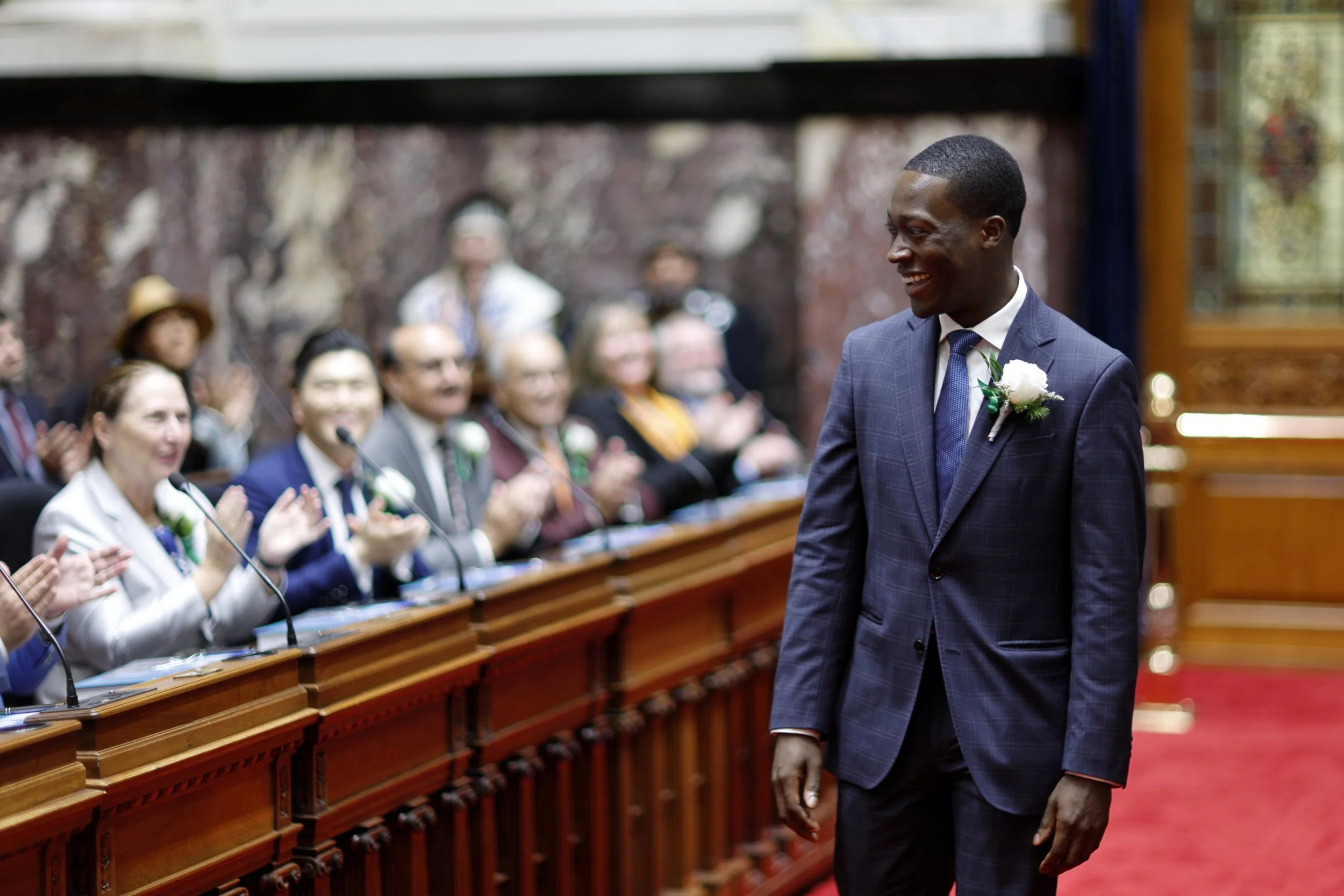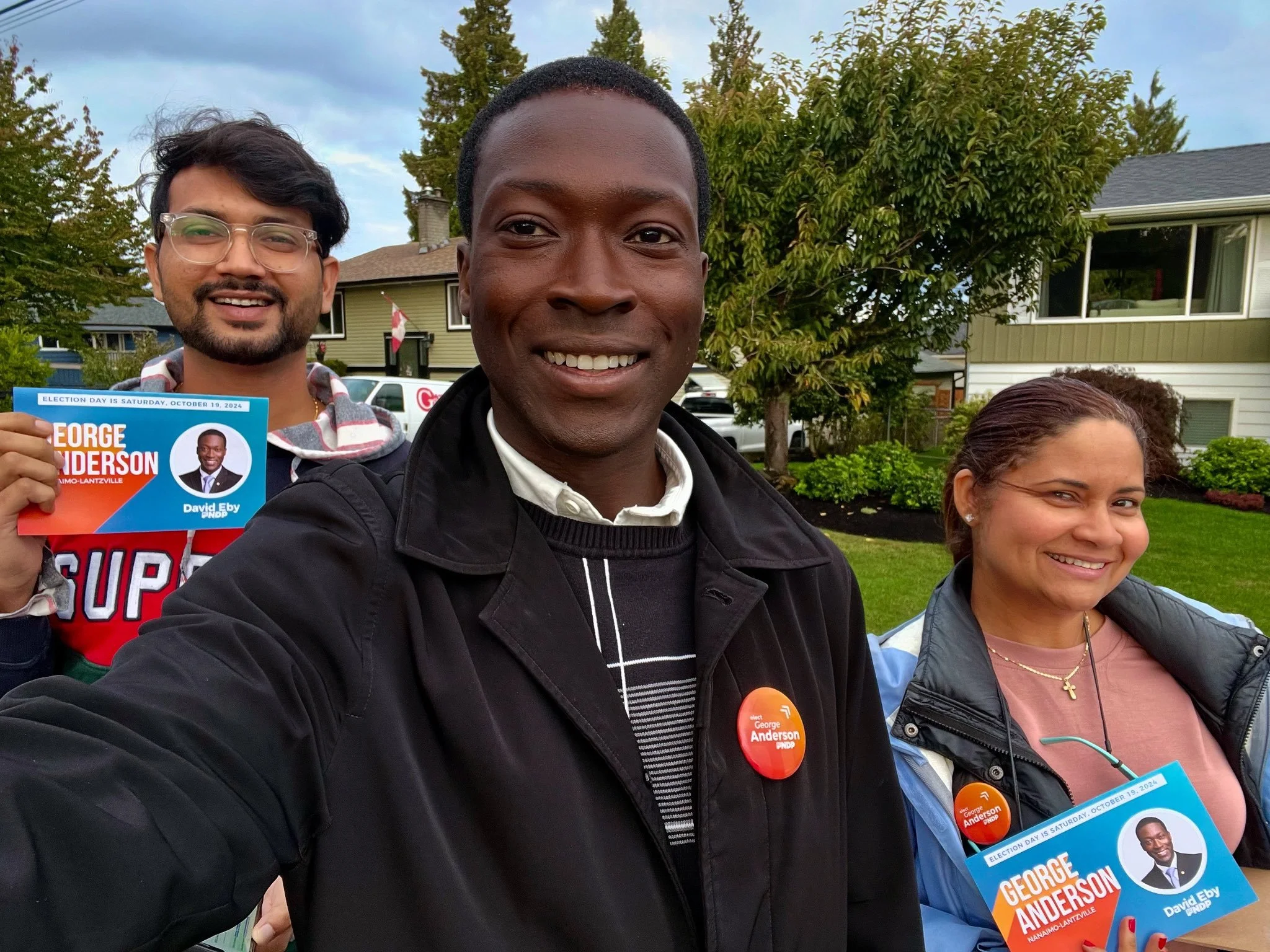George Anderson is British Columbia's third Black MLA
December 28, 2024
In many instances, people seek opportunities for personal and professional development.
For George Anderson, a political career was not on his radar.
Others recognized his excellent communication skills, wisdom, leadership, charisma, caring nature and humility and encouraged him to enter politics.
Anderson did and was elected to Nanaimo City Council during his freshman year at Vancouver Island University in 2011.
Last October, the New Democratic Party (NDP) of British Columbia member became the third Black politician elected to the province’s Legislative Assembly after winning 52 percent of the votes in the new Nanaimo-Lantzville riding which has a population of 56,881.
George Anderson at the swearing-in ceremony in Victoria with Premier David Eby and Lieutenant Governor Janet Austin (Photo contributed)
After three years on council, Anderson attended law school and practiced for five years.
“People came back and asked if I would be willing to make another political run,” said the 34-year-old Class Valedictorian in high school and university. “The world faces several challenges, including high inflation and income inequality. Having spoken with enough people in my community, I put my name forward.”
Born and raised in Nanaimo to Ghanaian immigrants who arrived in the urban city in the late 1980s, Anderson is excited to be part of a government that is committed to actively addressing climate change and building infrastructure, including roads, hospitals and schools.
George Anderson at the swearing-in ceremony in November 2024 (Photo contributed)
The province is supporting the new Simon Fraser University Medical School at the Surrey campus through $33.7 million in capital funding for interim space with $27 million in operational funding through the 2024 budget.
The British Columbia government also provided $14 million for the startup and planning of the new school, the first in Western Canada in 55 years.
It is expected to open in 2026.
“The NDP has been very much focused on building back a system that has been neglected for many years,” Anderson, the Parliamentary Secretary for Transit and Deputy Chair of the Committee of the Whole, said. “I am thrilled to be part of a government that is focused on all British Columbians, particularly those on the margins. We need a government that is focused on everyday people to ensure that their quality of life is lifted.”
Blacks have been an integral part of British Columbia’s history since Guyanese-born James Douglas, considered the founding father of the western province, invited African-Americans to become pioneers nearly 160 years ago.
They include tinsmith John Sullivan Deas who was the leading canner on the Fraser River in the 1870s. The tunnel on the south arm under the Fraser once bore his name but was renamed in 1967.
Aware of the province’s rich Black history, Anderson promises to shed light on some of the trailblazers, including Deas.
“I want to ensure there is some recognition of Deas so that he is not forgotten,” he said. “In my role as Parliamentary Secretary for Transit, I am fortunate to have that direct conduit to the Minister of Transportation to be able to talk about how we can ensure that that portion of history is not erased.”
Anderson also plans to use his political clout to advance Hogan’s Alley revitalization.
Vancouver’s first Black church, co-founded in 1918 by American rock guitarist/singer Jimi Hendrix’s grandmother --Nora Hendrix -- along with her workplace, Vie’s Chicken & Steak House, were central components of Vancouver Centre’s Black community in the Strathcona neighbourhood that was displaced over five decades ago by industry and the Georgia and Dunsmuir viaducts.
Many Black employees at the Great Northern Railway Station completed in 1916 also resided in the thriving Hogan’s Alley.
America’s first elected Black judge and abolitionist Mifflin Gibbs was Canada’s first Black politician, having been elected to Victoria City Council in 1866. He also built BC’s first railway, served as Victoria’s Deputy Mayor and played a pivotal role in the then colony’s entrance into the Canadian Confederation.
Midwife and Salt Spring Island resident, Sylvia Stark, delivered hundreds of babies and saw the island pass through its frontier stage to the modern era before passing away in 1944 at the age of 105.
Born in 1850 in the Danish West Indies which is now the United States Virgin Islands, John Freemont Smith lived in Victoria for a few years before moving to Kamloops in 1884. He owned a shoemaking business, served as an Indian agent, postmaster, secretary of the local board of trade and city assessor, wrote articles for mining and agriculture publications and was elected British Columbia’s first Black alderman in 1903.
“It is important that the stories of those Blacks who have made significant contributions in this province are incorporated in the very beautiful tapestry that is Canada,” noted Anderson who spent a few months studying at the University of Gallen in Switzerland in 2017 as part of an academic exchange program during his third-year at Osgoode Hall Law School.
George Anderson on the campaign trail (Photo contributed)
The creation and implementation of laws are among politicians’ main duties.
With a law degree, they have a better understanding of the law-making process and how ruling structures govern.
In Grade 3, Anderson drew a law school in a book that his parents recently showed him.
“That was a dream of mine and I am happy I got the opportunity to fulfil it,” said the youngest of four siblings and former Vancouver Island University Board of Governors Chair. “I was also thinking that if I was going to be a public servant again, that knowledge would be beneficial for my constituents.”
As a teenager just completing high school in 2009, Anderson was urged to run in the 2011 municipal elections in British Columbia, representing Nanaimo where he was born and raised.
Recognizing that Blacks should be part of the decision-making process and that he could bring fresh perspectives and innovative ideas to the political landscape, he threw his hat into the ring as a 19-year-old, relying on social media and door-to-door canvassing to get his message out.
Spending just under $5,000 on his campaign, Anderson’s message resonated with voters.
In the 2011 election, he made history as the youngest politician ever to secure a seat on city council after receiving the fourth-highest number of votes, 7,450.
A total of 26 candidates contested the election.
Finishing in the top tier guaranteed Anderson a spot on the 19-member Regional District Board that provides governance and services throughout Vancouver Island’s Central East Coast.
Then Nanaimo Mayor John Ruttan felt that the young political neophyte should allow an older politician to take the position.
When Anderson explained that constituents voted for him, Ruttan responded by email telling the newcomer he had lots of time to make a difference and he should relax because the window for older city council members was rapidly closing.
On the day of the city council inauguration, Anderson told the veteran politician that if he was removed from the regional board, he would tell the media what transpired.
The former Port Authority Chairman backed down.
In the run-up to last October’s provincial election, Ruttan endorsed Anderson.
“I met George Anderson when he was elected to the City of Nanaimo Municipal Council,” he said. “At that time, I was just starting my second term as the Mayor of Nanaimo. George was quick to demonstrate his understanding of City issues and was able to discuss these often-complicated matters in detail. A gifted public speaker, George Anderson is a kind and respectful person who will represent Nanaimo North and Lantzville riding with charm, knowledge and experience.”
During his three years on city council, he chaired the Transportation Advisory Committee and helped pass a 40-year transportation master plan.
Anderson also won council’s approval for e-town hall meetings to allow residents to use social media to engage councillors with questions and successfully pitched a youth advisory council for young people to be engaged in civic issues.
As a Regional District Director, he sat on the transit select and liquid waste advisory committees.
Pursued by the NDP, the Liberals and the Conservatives to run in the October 2014 provincial elections, Anderson declined and enrolled in law school at York University.
Late NDP members Emery Barnes and Rosemary Brown were the first Black politicians elected to the British Columbia Legislative Assembly in 1972. They were part of a political coalition that formed the first social democratic government in the province.
Jamaican-born Brown served for 14 years and also ran for the leadership of the federal NDP in 1975 with the slogan ‘Brown is Beautiful’.
Retiring from politics in 1988 to take a professorship in Women’s Studies at Simon Fraser University, she died in 2003 at age 72.
The first Black Speaker of a Canadian Legislature following his appointment in British Columbia in 1994, Barnes was an alternate high jump jumper for the United States at the 1952 Olympics and a 10th round pick in the 1954 National Football League draft. He played two games for the Green Bay Packers in 1956 before coming to Canada the next year and representing the British Columbia Lions.
Elected to the BC legislature in 1972, he was re-elected four consecutive times.
Barnes, the first British Columbia Black Cultural Association president, died in 1998.
A park bearing his name was unveiled in 2012.
In his election victory speech, Anderson acknowledged he stands on Barnes and Browne’s shoulders.
“I walk in the footsteps of these giants,” said the 2016 British Columbia Community Achievement Award recipient who volunteered with the Nanaimo-Ladysmith Public School Foundation, Literacy Central Vancouver Island and the Canadian Bar Association’s Access to Justice Committee. “If it was not for them and others, I would not be in the legislature today. They tried to make life better for the average British Columbian in the same way I am attempting to do.”









